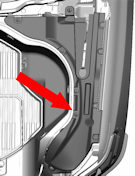EV fires Long about a week ago, we did a piece attempting to debunk misinformation about EV fires: they are not common; electric vehicles (EVs) do not explode; etc. It was clear, however, that high-voltage lithium battery fires are very difficult to put out. So we set out to look for best practices. They are: …
Author's posts
Permanent link to this article: https://dashboardsymbols.com/2025/07/getting-a-handle-on-ev-fires-getting/
Back-up cameras continue to be a big hit with NHTSA
Back-up cameras Its not so long ago that airbag recalls dominated the National Highway Traffic Safety Administration (NHTSA) announcements on X. These days, the “focus” is clearly on back-up cameras. Over the last 30 days, another seven recalls were announced involving some 25 models, all to address rear view cameras whose displays may not display. …
Permanent link to this article: https://dashboardsymbols.com/2025/07/back-up-cameras-continue-to-be-a-big-hit-with-nhtsa/
Smart symbols page is at last complete
Smart symbols page Its taken several weeks, but with the addition of a new child safety lock on indicator (left) our Mercedes-Benz division Smart symbols page is at last complete. The safety lock symbol is one of at least a dozen new symbol we had to create for the page. We also generated 11 new …
Permanent link to this article: https://dashboardsymbols.com/2025/07/smart-symbols-page-is-at-last-complete/
Smart aggravates our speed limiting page
Speed limiting The Smart division of Mercedes-Benz created two sets of Speed Limiting indicators, and did it in but two model years! It leaves us with 28 entries covering speed limiting on the page. The first set inverts the more common use of the LIM acronym, moving it to the top like the one to …
Permanent link to this article: https://dashboardsymbols.com/2025/07/smart-aggravates-our-speed-limiting-page/
Ford EV jump starting video added to YouTube
EV jump starting Today we added a new video to our YouTube channel describing Ford EV jump starting. It also anticipates that the driver is locked out and includes instructions for getting inside. The video joins the new jump start playlist that now holds four videos. Every electric (EV) vehicle uses a 12-volt “start” battery …
Permanent link to this article: https://dashboardsymbols.com/2025/07/ford-ev-jump-starting-video-added-to-youtube/
Electric trailer hitch operation indicators
Electric trailer hitch These are Electric Trailer Hitch Operation indicator symbols. From the Smart division of Mercedes-Benz, this hitch system can be released or retracted from inside the vehicle. The system also performs a lighting connection check automatically and can attest to whether or not a trailer is connected. Before continuing, is one of these …
Permanent link to this article: https://dashboardsymbols.com/2025/07/electric-trailer-hitch-operation-indicators/
Lightning and Transit EV jump starting far simpler than the Mach E
EV jump starting As we assemble our next EV jump starting video, this one for Ford, we’ve found that procedures for Transit and Lightning EVs are far easier and more straight forward than the Mustang Mach E, as we noted in another post. And it “starts” with the fact that the two trucks use a …
Permanent link to this article: https://dashboardsymbols.com/2025/07/lightning-and-transit-ev-jump-starting-far-simpler-than-the-mach-e/



Marc Favreau
The author has 30+ years of automotive experience and has assembled the most extensive collection of symbols and warning lights anywhere (over 1,000!) and can help you open and start any keyless start car with a dead key fob battery. BA, St. Joseph's, ME: MS, RPI, NY
Most commented posts